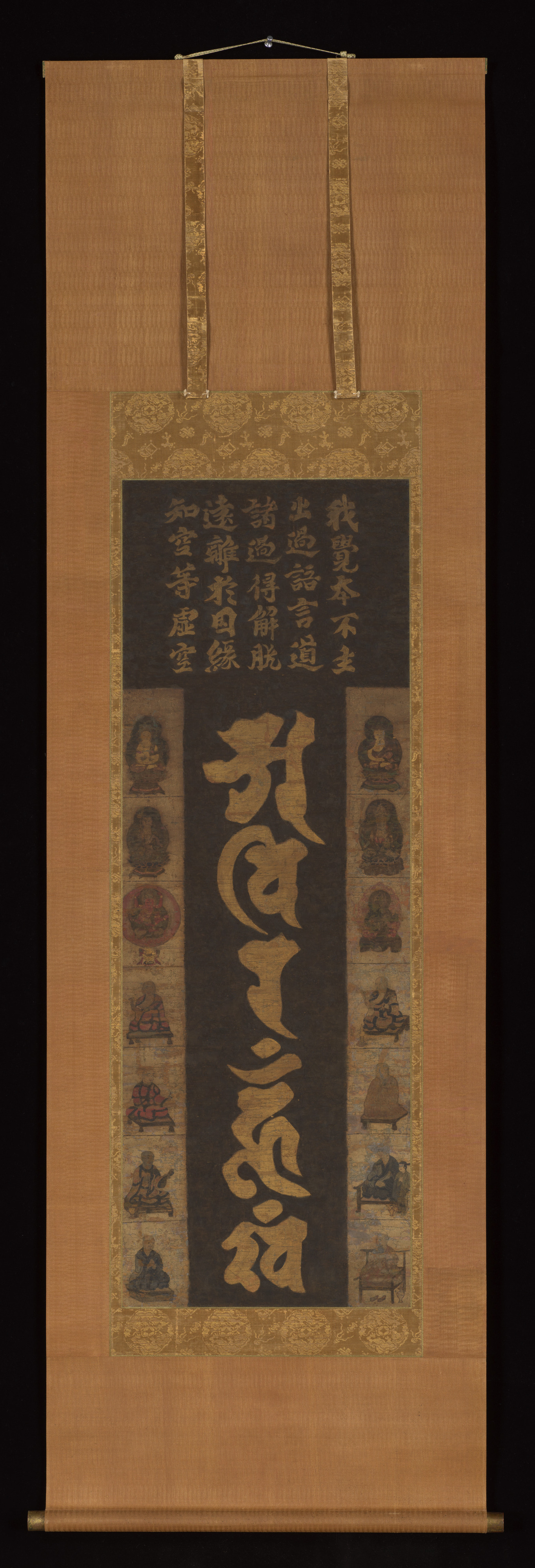Mandala in Sanskrit with Buddhas, Bodhisattvas, and Eight Patriarchs of the Shingon Sect
The focal point of this small hanging scroll is a column of five Sanskrit characters, painted in gold, that can be pronounced: “A vi ra hūm kham,” referring to the five elements (godai), namely, earth, water, fire, wind. Originating from the Indian Buddhist concept of Mahabhuta, the five elements are believed to form everything in the universe. These sacred syllables comprise a mantra (magical formula) that Dainichi, the Cosmic Buddha (Mahavairocana) is said to have uttered when subduing Mara, or forces of evil. This mantra is also believed to articulate the “omniscient wisdom” of the Cosmic Buddha. The worship of Dainichi and the scriptures and ritual protocols associated with him are central to the beliefs of the Shingon sect of Esoteric Buddhism, established in Japan by Kūkai (also known as Kōbō Daishi, 774-835) during the ninth century.
A scroll such as this could have been used for preforming esoteric Buddhist rituals in a private chamber that could not have accommodated a large set of Two-World (Ryōkai) Mandalas, comprising the Womb and Diamond Mandalas that are displayed over altars during esoteric Buddhist ceremonies at Shingon and Tendai temples. The mantra and depictions of deities and patriarchs were meant to be experienced as living entities necessary to ensure the efficacy of the rites performed in their presence.
Inscribed in gold above the mantra are Chinese verses taken piecemeal from a section of the Vairocana’s Awakening Sutra:
我覺本不生 出過語言道 諸過得解脫
遠離諸因緣 知空等虛空
My awakening is originally unborn,
and transcends ordinary language.
From all transgressions awakening is achieved,
far removed from all causes-and-conditions,
knowing emptiness to be conterminous with empty space.
—Trans. adapted from Daniel B. Stevenson
Flanking the column of Sanskrit seed syllables are small, meticulously detailed images of Buddhas and Bodhisattvas vital to Esoteric Buddhism, along with Eight Patriarchs of the Shingon Sect —both deities and historical figures—as they are revered in Japan. They can be identified as follows:
Left (from top to bottom):
Dainichi (Sk. Mahavairocana, or Vairocana), of the Diamond Mandala
Jizō (Sk. Ksitigarbha)
Aizen Myōō (Sk. Ragaraja)
Ryūmō (also known as Ryūju; Sk. Nagarjuna, India, ca. 250)
Ryūchi (Sk. Nagabodhi, India, ca. 500)
Kongōchi (Sk. Vajrabodhi, India, 671–741)
Fukū (Sk. Amoghavajra, India, 705–774)
Right (from top to bottom):
Dainichi (Sk. Mahavairocana, or Vairocana), of the Womb Mandala
Eleven-headed Kannon (Sk. Ekadasamkha)
Fudō Myōō (Sk. Akalanatha)
Zenmui (Sk. Subhakarasimpha, India, 637–735)
Ichigyō (Yi Xing, China, 683–727)
Keika (Hui Guo, China, 746–805)
Kūkai (Posthumously, Kōbō Daishi, Japan, 774–835)
This image cannot be enlarged, viewed at full screen, or downloaded.
This artwork is meant to be viewed from right to left. Scroll left to view more.



